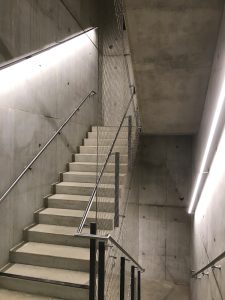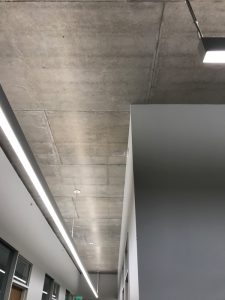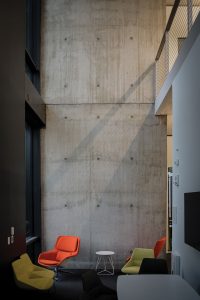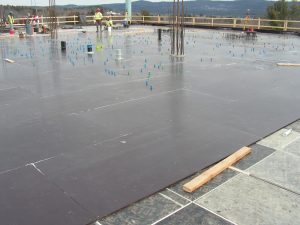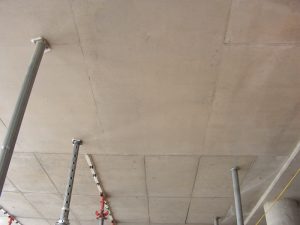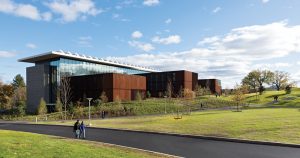The New Science Center (NSC) at Amherst College in Amherst, Massachusetts, has several eye-catching features: from its column-free glass-walled commons space to its rooftop garden, transparent lab spaces, and hung atrium corridor and stair. To be certain, these features are striking, clean, and inviting, but there is a common theme that bonds all these disparate elements. One might notice that it is not the building’s highlights that make it functional; the consistency of the architecturally exposed concrete is key.
The Boston-based architectural firm Payette designed the NSC, bringing on LeMessurier as the project structural engineer.
The NSC is comprised of four distinct parts: an east bar which houses offices, laboratories, and common spaces, and acts as a central hub for each of the three distinct departmental pavilions which project outwards onto the campus landscape, not dissimilar to an airport terminal which shoots off to any number of gates. Specific attention was paid by the design team to the consistency of the exposed concrete surfaces to showcase commonality throughout the four spaces.
The project was conceived as a cast-in-place concrete structure, which was embraced as a part of the project’s aesthetic. The concrete would be visible throughout the NSC, not as a feature element but as a backdrop serving to highlight the beyond-the-traditional structural design topics of strength and stiffness. The first question was, “what should it look like?” The architectural goal was simple: the concrete should be its natural gray, and it should be the same everywhere with no specific preferences beyond that. In short, the goal was the consistency of appearance.
In the absence of finishes, concrete is a uniquely challenging material from which to obtain consistency: so many of its constituent parts are regionally variable, the forms it touches change its appearance, and the placement and curing processes can lead to imperfections.
The process to identify and specify measures to ensure consistency began with research into many of the American Concrete Institute’s guides about materials, placement, forms, curing, stripping, finishing, protection, and prevention of imperfections. Equally as important as deciding critical appearance aspects of the concrete was the ability to describe the project requirements to the construction team. While the structural drawings show the concrete thickness, location, reinforcement, and even shape, the drawings are an inelegant vessel for describing appearance. It became necessary to prepare a specification for cast-in-place concrete tailored to the project.
The concrete specification was broken into several subsections related to the appearance of the concrete: definitions – what did the terms mean; materials – what was the concrete comprised of; and, execution – how was it to be built.
Definitions
At the NSC, not all concrete is created equal; it was not possible for all 251,000 square feet of the concrete to be visible, so there was no need to undertake the effort and expense of treating all concrete as architecturally exposed. Further, some of the exposed surfaces were formed, and others were finished, each requiring their own methods of execution. To describe which regions needed special attention, and what type of attention, the specification introduced Architectural Concrete Regions 0 through 5, which identified areas such as undersides of slabs, concrete columns, and pigmented exterior concrete walls and panels.
- Architectural Concrete Region 0 (AC-0): This is the concrete throughout the project that is not otherwise specified in regions 1 through 5 below.
- AC-1: This is concrete consistent with AC-0 except requiring surface treatment after the removal of formwork.
- AC-2: Undersides of slabs; cast-in-place concrete stairs.
- AC-3: Vertical concrete walls.
- AC-4: Concrete columns exposed to view; excludes other columns.
- AC-5: Exterior concrete walls at loading dock region; pigmented.
Beyond defining each type of region, the locations needed to be delineated as well. To do that, Payette provided key plans that were inserted in the cast-in-place specification.
Materials
When considering the appearance of concrete, not only do the constituents contribute but also any other material that contacts the concrete during placement.
Of the concrete constituents, no specific preference was given to their makeup other than that the constituents needed to be single-sourced; this requirement was added into the specification directly in several subsections (aggregate, cement, water, etc.). Each level in the NSC is over an acre in area, so each floor plate was completed in multiple concrete placements, with some adjacent slabs being placed more than a month apart. Single-sourcing provided the most reasonable safeguard against adjacent concrete placements having slightly different mixes. In addition to single-sourcing, the specifications required that each type of placement use the same mix design; all slabs needed to contain the same type and quantity of admixtures, as did the columns. Mixes were not required to be consistent between structural elements (i.e., the slab mix was not required to be the same as the column mix). The specification included the following to achieve this:
When admixtures or combinations of admixtures are included in Architectural Concrete Regions 1 through 5 as defined above, the admixtures shall each be from a single manufacturer and a single provider to maintain the consistency of placement, finishing, and appearance throughout the project.
After the constituents, the specification addressed the materials for formed surfaces which would change the texture of the exposed concrete. The requirements for each type of element (slabs, stairs, walls, and columns) are directly in the specification. For example, the following specification language was added for Architectural Concrete Regions 2 and 4:
- AC-2 Slabs: High-Density Overlay (HDO) Plywood lined with forms for slab soffits. Joints in forms and plywood panels shall be aligned and placed per the Drawings. Each panel of HDO Plywood shall be used only one time to form the slabs in AC-2; re-use of HDO plywood is not acceptable. Corners at all exposed corners shall be formed with a ¾-inch chamfer strip.
- AC-4: Custom-fabricated; column forms without seams that result in no expression of form material on the finished concrete surface.
Execution
A well-crafted set of drawings and specifications will only get a project so far. The design is only as good as how well it is built. By way of example, the NSC has two adjoining common spaces which are connected by straight runs of cantilevered concrete slabs nearly 300 feet in length. To ensure that the edge of the slab was as straight as possible, the specification adjusted the standard concrete construction tolerances described in the American Concrete Institute’s Specification for Tolerance for Concrete Construction and Materials (ACI 117) by setting a hard limit to the maximum deviation of placement of ¼ inch. Other AC regions were described with a reduction in tolerances such that the concrete placement was 50% more strict than described in ACI 117.
As the design progressed, the concrete subcontractor was engaged early to advise on the specification language about which tolerance limitations were practical, at the location where a feature element was being showcased, so that it would not be unduly burdensome or expensive to achieve the design aesthetic.
One inherent challenge with an exposed cast-in-place concrete structure is that the concrete is the final visible surface and will be trod upon by the trade workers while the building is fit out, causing inadvertent wear or damage to the concrete. For important architectural concrete surfaces – such as columns, walls, and exposed slab soffits – the concrete was protected throughout the remaining construction. For columns and walls, the protection was primarily against striking the surface with equipment or materials, so a wrap was provided at the base to prevent damage. Similarly, the reshoring posts that were used to support architectural concrete were topped with a pad between the post and the slab to prevent dings and scrapes.
Quality Control
A tremendous effort has been undertaken to get to the point of depositing concrete at a project site, including setting shoring, formwork, rebar, spacers, and cleaning the forms. This is a time-consuming, labor-intensive, and often costly procedure. Therefore, the architectural concrete regions must be placed with confidence to ensure the quality of the product; rejecting concrete is likely to have significant cost and schedule implications that ripple through a project until its completion. Steps taken before concrete placement to ensure quality work will pay dividends as construction progresses.
For the NSC, the concrete work kicked off with a preconstruction meeting with Amherst College, Payette, LeMessurier, Barr & Barr, S&F, as well as inspection agents and other stakeholders. This meeting acted as a starting point to review the concrete scope and talk with one another about questions, concerns, intents, and goals before the formalities of submittals and RFIs. After the preconstruction meeting, a concrete mockup structure was built, serving as a baseline for levels of acceptance of the architecturally exposed concrete surfaces. The mockup included several of the most challenging construction details (slab elevation changes, rectangular beam framing into a round column, the transition from form liners to traditional forms, and coordinated form tie locations) that might lead to imperfections in the concrete. The mockup allowed the contractor to determine the best method of construction for each of these difficult aspects and allowed the design team to identify achievable surfaces for the architectural concrete versus regions of rejectable concrete surfaces. The most challenging concrete proved to be the placement of the round columns; consolidation and rebar cover were a deficiency in the dedicated mockup, so additional back-of-house locations were found in the main building to gain further experience with the columns before the architecturally exposed columns were placed.
Key Takeaways
There were a few key decisions during the design and preparation of the contract documents for the NSC, which can be grouped into three primary aspects: Research, Specification, and Mockup.
The Research component gathered as much information as possible from as many sources as available; find the components of the concrete that can be controlled, ask questions of the teams that will be responsible for constructing them, and determine which of the concrete characteristics are important to the project. The Specification should identify each of the pertinent technical characteristics of the concrete imperative to a successful finished product and describe each in as much detail as possible. Implementing the specification language on a sample Mockup prior to construction on the full project will allow the team to understand the project requirements at full scale, practice constructing challenging details, and determine the quality standard for myriad conditions.
Employing these steps early in the process will allow the full project team to come together to deliver a project as successful – and consistent – as the New Science Center has been for Amherst College.■
Project Team
Owner: Amherst College, Amherst, MA
Structural Engineer: LeMessurier, Boston, MA
Architect: Payette, Boston, MA
Construction Manager: Barr & Barr, New York, NY
Concrete Contractor: S&F Concrete, Hudson, MA

